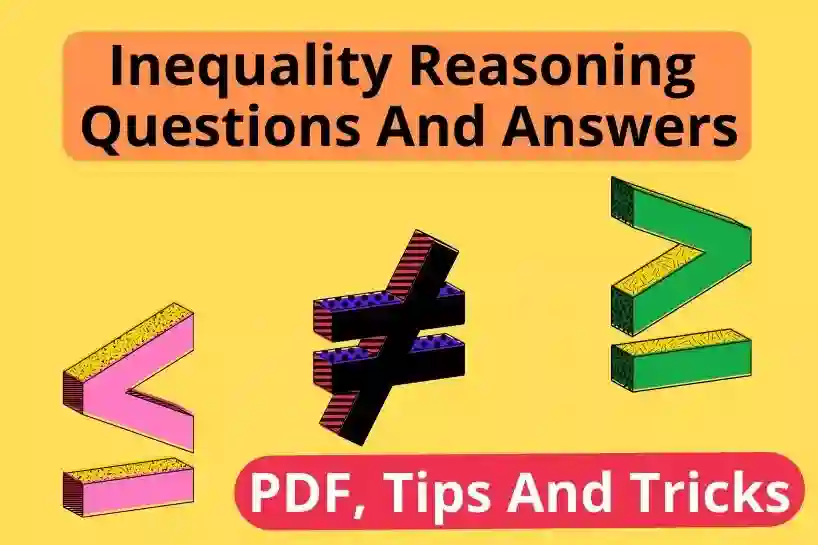Inequality is a part of reasoning topics that are mostly asked in various competitive exams. in this post, we Explain some examples of inequality reasoning questions and answers for the student who took a government exam preparation. Sometimes They don’t know How to solve reasoning inequality questions with tips and tricks. This post also covered Easy too difficult types of inequality reasoning questions And answers with explanations that help to increase you are raising performance. Also, provide inequality reasoning questions and answers pdf.

- What Is Inequality Reasoning Questions and It’s Types
- Inequality Reasoning Questions Basic Symobols
- How to Solve Reasoning Inequality Questions
- Inequality Reasoning Questions Tricks and Tips
- Inequality Reasoning Questions And Answers
- Examples of Inequality Reasoning Questions And Answers
- Inequality Reasoning Questions And Answers for competitive Exam
- Inequality Reasoning Questions And Answers pdf download
- Conclusion
What Is Inequality Reasoning Questions and It’s Types
Inequality reasoning topic is all about the comparison between two or more variables that conclude them with a variable statement of question By using some inequality symbols like Greater than or equal to(> or ≥), smaller than or equal to (< or ≤), equal to (=) with the help of this symbol Conclude the possibility of statement for answer the Inequality question
There are three types of Inequality Reasoning Questions asked in various exams
- Simple Inequality (Statement and Conclusion)
- Conditional Inequality (Atatement Condition Based)
- Coded Inequality (Coded Statement and Coded Conclusion Based)
Inequality Reasoning Questions Basic Symobols
“>” Greater than → ( A > B) → A is Greater than B.
“<“ Less than → ( A < B) → A is Less than B.
“=” Equal → (A = B) → A is Equal to B.
“≥” Either Greater than or equal to → (A ≥B) → A is either greater than or equal to B
“≤” Either Less than or equal to → (A ≤ B) → A is either Less than or equal to B
How to Solve Reasoning Inequality Questions
Sometimes during solving Inequality reasoning we think it is a right but in reality, it turns out to be wrong. Before solving reasoning inequalities questions you should know about the upcoming possibilities of the given conclusion from their statement, which are mentioned in below table
| Statement | Possibility | Conclusion |
|---|---|---|
| A>B>C | No possibility of the statement | A>C |
| A ≥ B> C | A>B>C → A>C | From Both or Possibility are |
| A=B>C → A>C | Getting A>C so conclusion will be A>C | |
| A>B ≥ C | A>B>C → A>C we are getting or A>B=C → A>C | From Both Possibilities A>C so The conclusion will be A>C |
| A ≥ B ≥ C | A>B>C → A>C or A=B>C → A>C or A>B=C → A>C or A=B=C → A>C | From the first three possibilities, we are getting A>C but from the last one, we are getting A=C. so the combination of these two A≥C will be the conclusion |
Inequality Reasoning Questions Tricks and Tips
Step 1: Check symbols are in the same order or not
step 2: if symbols are in the same order then check there is only a single inequality symbol between those two elements we are comparing.
step 3:
(a)(i): If yes, then the conclusion will have a single equality symbol between them in order to make conclusions and definitely true ( follow)
(ii) if no, then there will have Double equality symbol between in order to make the conclusion definitely true ( follow)
(iii) if neither symbol not double sign is present between them and only ” equals to” Tu is present it then the conclusion also must have “=” sign to make it definitely true
(b) if symbols are not in the same order in the statement then entities that are being compared will always give “no relation” because of which only conclusion related to them will give can’t say ( does not follow) as the answer.
Inequality Reasoning Questions And Answers
Here we start 1st type of inequality i.e simple Inequality Reasoning Questions And Answers
Q1-5. P ≥ Q ≥ R = S ≥ T > U ≥ V = W < X
A. Only Conclusion I is true.
B. Only Conclusion II is true.
C. Either Conclusion I or II is true.
D. Neither Conclusion I or II is true.
E. Both Conclusion I or II are true.
Q1.
Conclusion
I. P ≥ U
II. P > U
Q2.
Conclusion
I. T ≤ Q
II. T < Q
Q3.
Conclusion:
I. P > T
II. P = T
Q4.
Conclusion
I. T > X
II. T > W
Q5.
Conclusion
I. U > X
II. U ≤ X
